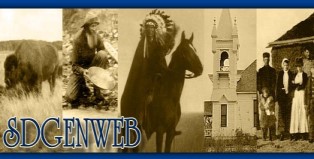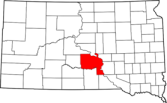80 YEARS AGO
Jan. 25, 1917
Lyman County Argus, Oacoma
Lyman
County first opened for settlement
Monday, Feb. 10, 1890, when
a gun was fired off at Chamberlain to
signify that the great Sioux
Reservation, consisting of 14 counties west of the
Missouri River,
was open for settlement.
Land was taken
under what was known
as "squatter's rights". Terms-$1.25
per acre paid to the US
Government and must reside
on the quarter for five years; a quarter of land per
home site.
The
only settlement in the county previous to opening
the reservation, was down-river (southwest) a short
distance from Oacoma, called Lower Brule. Many people
were employed by
the US Government and lived there to take care
of the Indians. There
were churches, schools, shops,
warehouses and offices;
a post trader who
kept merchandise and
a court consisting of Indians before whom the
Indians settled their
controversies, and a number I of houses and
other buildings used for
different kinds of work were erected there.
A
provision made by an Act of Congress to open
land for settlement. Indians wishing to
stay, could. Others left
for the reservation north
up-river. The agency settlement remained on
the river for several
years after the homesteaders came. The
Indians were scattered all
over the county in separate camps, and came in
at stated times for
supplies.
Oacoma
was started mostly by a lot
that came from Plankinton who took great interest
in building up a town.
They named the town Sherman. Sherman was
short-lived; a dispute
among themselves over the
interests of different parties caused the US Govt. to
require all to move off
the site. Soon,
another attempt was made
to start a town, calling it
Gladstone. The parties were again ordered
off by US authorities. Some moved a distance
north and the site required
a name.
Dr.
James Rigg of
Plankinton gave it the name O-A-Coma. The
Oacoma post office was
established at this location with Mr. Rigg as
postmaster.
A
land office was established at Chamberlain and
there, an application for a town site was filed for the new town of
Oacoma.
(Very long history follows. Newspapers on microfilm at
Cozard Memorial Library.)
Oacoma
by Florence Holmes Wait, 1961
Oacoma's
first school was started the fall of
1895, in a rented store building belonging
to Jay Wellman. The first teacher was Miss
Myrtle Farmer of Chamberlain. Florence
Holmes, just five years old the preceding
June, was one of the first pupils, together
with Mabel Kenaston, Emily and Agnes Auld
and some Hickey children. Parents had to
purchase the school books for the children
at the Kenaston General Store. Classes were
differentiated as "Readers." A child started
in the primer then to first reader and
advanced according to his or her ability to
read.
School was held the second year
in the Fulford building on the south side of
Main Street with Bertha Stocks as teacher.
Miss Mary Stocks also taught a year or two.
Mr. E. E. Morford taught one year. Then the
school was moved to a residence northwest of
the courthouse. Miss May Griffin of Kimball
taught two years until she married Henry
Juelfs and moved onto a farm at Dirkstown.
Some years later a frame two-room
schoolhouse was built in the north part of
Oacoma. Mrs. C. S. Brackett of Chamberlain
taught two years, also Mrs. (Dr.) Chaney,
Miss Bertha Smith, sister of Frank Smith of
the Whitbeck Bank. After attending school
for 12 years, Florence Holmes was the first
high school graduate; and the first
graduating exercises were held May 5, 1905,
in the Christian Church. Florence wore a new
white graduating dress made by her mother
and read an essay entitled, "The Value of a
Purpose." The school superintendent that
year was Professor J. D. Rouse.
The Congregational Church
was organized soon after Oacoma became a
town. A minister from Chamberlain drove a
horse and buggy over and held services on
Sunday afternoons in the Fulford building
upstairs hall. The little Episcopal
Chapel was purchased after Lower Brule
Agency was moved. The Congregational Home
Board of Missions helped to pay the $200 and
the deal was negotiated through the
Episcopal Bishop Hare. The building was
located on the south side of Main Street.
The Rev. George E. Brown was the first
resident pastor. He had a wife and three
children, David, Jr., Jack and Helen.
Preceding that, the Rev. David Parrin had
preached in Oacoma as a summer student
pastor. He later married Miss Lora Walker,
whom he met there. About 1903, Rev. George
W. Dodge, a single man, came to Oacoma and
began to hold religious revival meetings in
Martins' Store Hall.. They continued for
several weeks that summer and Disciples of
Christ Church was organized as a result. Two
lots on the west side of Lichenstein Street
two blocks north of Main Street were donated
by a Mr. Lemuel Wait and his wife. A church
building was built with some volunteer
labor. It was called the Christian
Church. In 1933 the little Congregational
Church building burned. By that time
the Christian Church discontinued so the
Congregational Conference negotiated for the
Christian Church building which was used for
several years, being served by ministers
from Chamberlain. About 1960, the Oacoma
Church was merged with the Chamberlain
United Church of Christ which was formerly
called the Congregational Church. Sunday
School was maintained in Oacoma for a time,
then the building was left vacant. With some
alteration it was finally turned into a
Fellowship Memorial Hall used by the Womens
Fellowship for their monthly meetings.
One of the first resident doctors
in Oacoma was Dr. J. Y. Batterton. He and
his bride came from St. Louis and
settled in Oacoma. He started a drug store.
Previously "patent medicines" such as
"Peruna," "Lydia Linkham's Pink Pills for
Pale People," "Swamp Root," "Fletcher's
Castoria," "Allen's Footease," along with
castor oil, liniments and cough syrup, were
to be bought at the general store. After Dr.
Batterton moved to Eagle Butte, a Dr. I.
Ishkanian, a Syrian by birth, came to Oacoma
and was a fine physician. He arrived there
in the early thirties. He was a good singer,
guitar player and took ardent part in the
establishment of the new Christian Church.
But some sort of gossip or scandal had
followed him and he was forced very unfairly
to leave.
Sickness and Funerals
"Consumption," now known
as tuberculosis, was very common and
"consumptives" went about spitting on the
street during their prolonged illness, and
mortality ran high as a result. Diphtheria
was a dreaded disease and took a great toll
of lives of young and old. It was extremely
contagious and sometimes several members of
one family would succumb to it. Scarlet
fever caused the death of many children as
did measles, smallpox and whooping cough.
Vaccination for smallpox was just being
started at the turn of the century.
Embalming was not accepted when it was
first introduced. The older people were very
much opposed to it. Upon the death of a
relative or friends, a coffin was purchased
in Chamberlain at the furniture store and
friends "laid out," that is washed and
dressed the corpse as a friendly service.
Cloths were soaked in salt peter and kept
moist over the face to prevent
discoloration. Pennies tied in bits of cloth
were laid on the eyelids to keep them
closed. A few geranium blossoms picked from
house plants were the first flowers used.
Kindly friends often lined the
unsightly open grave with strips of muslin.
A baby's coffin was often carried on the
knees of relatives to the graveyard.
"Setting up" with the corpse was a custom
and presumably necessary to keep the face
cloths moistened. Several friends gathered
at the home of the dead person and stayed up
all night visiting, and a lunch was always
served about midnight. Metal ornaments
on the top of the coffin were often removed
after the funeral to be saved as
"keepsakes."
Funeral services were usually held in
the homes with a choir or quartet providing
the several songs. Long tear-provoking
eulogies, sometimes scarcely recognizable as
referring to the departed person, were read
at the funeral service.
Oacoma
history
by barbara speck, 1996
The town site, surveyed by
Newton Gilbert, was completed Aug. 19, 1891,
when the 55.15 acres of land received was
surveyed and platted as Gladstone while
Benjamin Harrison was president.
The patent for the town
of Oacoma was obtained from the US
Government July 14, 1893, by Lyman County Judge John G.
Bartine, and recorded in Register of Deeds
I.N. Auld’s office July 24, 1893. The town
became the first county seat for Lyman
County (1894). The original courthouse
building burned to the ground. It is
believed to have been set afire by men who
were being tried for cattle rustling.
The Lyman County
Courthouse was eventually moved to Kennebec
in 1922, following a near riot as people from Reliance
and Iona joined Oacoma in an effort to keep
the seat in Oacoma. In an article in the
Oacoma Argus Leader, dated Nov. 14, 1922,
Kennebec won the right to move the seat to
Kennebec by 11 votes. Several county
officers in favor of the move were from
Kennebec, which made it difficult for Oacoma
to defend the ballot boxes which had been
secured in the clerk of courts office, who
also happened to be from Kennebec and is
alleged to have unlocked the doors to his
office long enough for the Kennebec men to
secure the boxes before the Oacoma men
discovered the theft. In a related article
in the Oacoma History Book, the following
reads: "We stood on the hill west of town and
watched as lines of cars taking the county
records left for Kennebec when Oacoma lost
the county seat."
Many early travelers and
settlers stopped overnight at Oacoma,
resting their livestock and horses before
starting for Chamberlain and parts east in
the mornings, crossing the river by ferry or
pontoon in the warm months and over the ice
during the winter months.
Once the area was opened
to homesteaders, the town
site grew rapidly with such
necessities of life as lumberyards (two),
two banks, two newspapers, blacksmith shop,
restaurants, hotels, drug store, land
offices, lawyers, doctor, three grocery and
general merchandise stores, fire and
sheriff’s departments, a jail, saloons, and
of course, the courthouse.
The town’s first
ordinance was for the control of alcohol.
Graceland Cemetery dates back to 1890, or
earlier. The first school (a two-story
wooden structure) burned to the ground in
1907, and school was held in various
buildings before the new brick building of
today was built in 1925. Parents bought
their children’s school books from the
Kenaston General Store in 1895. Florence
Holmes-Wait was the first person to graduate
from Oacoma High School, May 5, 1905. This
building was used until closing permanently
in 1995.
Basil Hickey built the
first hotel in town; first sidewalks in
1905, on both sides of Main Street; in 1909,
sidewalks were built on the east side of
Auld Avenue to the railroad crossing, and by
1911, residents were required to build their
own sidewalks in front of their property or
the town would do it for them and bill them.
The mail schedule to
Chamberlain from Oacoma in 1904, was: Lv.
6:30am, Ar. 7:45am and Lv 6:40pm, Ar 8:10pm.
In August of 1905, the
railroad crossed the river; the first rail
service being the White River Valley Rail
Service Co. The first telephone reached
Oacoma in July; county judge, C.S. Argo;
notary, Frank Smith; reg. o deeds, Wm. V.
Cullen; county auditor, Chris Mhyre; editor
and publisher of Gazette Leader, Wm.
Williamson; Lyman County Sheriff, John R.
Pickett, and cattle inspector, Leo N.
Dunkel.
First jail, 14’
wide x 9’ high, and the first organized town
cleanup in 1906-07. Wm. McManus was the fire
chief, street commissioner, city pound
master and town marshal, all for $50 per
month. The city had purchased a 60-gallon
fire engine. Elwood Kentch was appointed
town marshal Sep. 3, 1912. Oacoma almost
became a dry town Apr. 23, 1910, when 29
people voted against selling liquor and 30
voted for. Also in 1910, the city purchased
220’ of fire hose and a fire department was
formed with Frank McManus, chief.
Some taxes noted include:
Bartine’s taxes for ½ block of land in 1907-
$75; Peter Dirks was taxed $50 for a diamond
ring in 1909; J.E. Stanley assessed $100 for
an automobile in 1912; Frank Harmon was
assessed for two cows, and Charley Hodgin a
tractor, in 1937. A poll tax in 1909, of
$1.50 for each able-bodied male 21 and over.
And, last but not least, a dog tax of $1.50
for each male, and $2.00 for female dogs.
A mild earthquake shook
the town early in the morning of Jan. 2,
1922. No damage done although some dishes
were rattled and spilled onto the floor.
The city’s artesian
water well was drilled in 1936, by A.V.
Depue under WPA Docket 7414. A fee of six
dollars per year was charged each resident
with a tap.
In 1938, the Oacoma Town
Hall was built (from lumber from the old
abandoned courthouse) on lots 11, 12, 13 and
14 of Block 13, donated by M.Q. Sharpe.
The Oacoma City Park
committee and many volunteers from the
community created the beautiful park Oacoma
now has. Part of the equipment found in the
park today came from the West Park
Campground (1995) located where Cedar Shore
Resort sits (NE of Oacoma along the banks of
the Missouri River) today. The equipment and
picnic shelters and barbecue grills, as well
as the two mandatory out-houses, were moved
over to Oacoma prior to construction of the
resort.
New water and sewer lines
accommodate Oacoma's water system installed
in 1994-'95.
At this time
(1996), Oacoma has the distinction of being
the fastest growing small community in South
Dakota with the construction of two
fast-food businesses, three motels, the
resort, Chevrolet dealership and western
wear store, two convenience stores, two car
washes, laundromat and three apartment
buildings, all in the '90s!
By 1998, the
city had installed concrete streets
throughout the town with the exception of
Main Street and a portion of Dougan Ave.
Housing development continues in the Priebe
Addition north of town and in the village
proper. A second campground, Hi 'n
Dri, sits north of the business loop,
Exit 260.
Note - 2008: All
main streets in Oacoma are concrete. Many
new homes have been constructed along the
county road leading north out of Oacoma with
an additional small housing development
located on the flats beyond the top of the
hill. Six houses have been constructed .
Cedar Shore Resort has added a convention
center to their facility, and the Town of
Oacoma built a large beautiful
community/convention center at I-90 Exit
260. A Shell station/convenience store,
second car dealership and large antiques
facility have also been established along
the business loop. Oacoma's oldest business,
Mueller's Store/Al's Oasis has been enlarged
to include a small mall area between the
restaurant and expanded grocery store.
Oacoma's newest business (2007) is a branch
of First Dakota Bank located in Al's
Oacoma
Written
by Ben Brave. Taken from SD archives, 1943
The
town site of Oacoma grew up near the Lower
Brule Indian Agency in the south central
section of South Dakota. The agency was
located on the flats and foothills two miles
west of the Bice property, southwest of
present-day Oacoma. Approximately 1,400
Lower Brule Sioux Indians were encamped
there. The historic Lower Brule Indian
Agency Cemetery can be seen at the bottom of
the west hill out of Oacoma. The main agency
house (Atey Api Ote) was used for officer’s
quarters where business matters and treaties
took place.
Near the agency, a
village of about 100 log cabins, an
Episcopal Church, a Mission house, shops,
office, warehouses and trader post and a
school stood. Originally named Nobleton,
then Sherman, and finally, the name was
changed to Gladstone as indicated on many
abstracts of property in the west half of
Oacoma. On the east side of Gladstone, (Aug.
of 1890) the US Govt. established a post
office named Oacoma.
Sept. 11, 1888,
commissioners came and were welcomed at the
agency headquarters for the great treaty of
the Grand Sioux Reservation under the
Cleveland Administration. The chiefs signed
or touched the pen and went to other
reservations in all of Dakota Territory.
July 1, 1889, Atey Api Ote opened
headquarters for Rep. Commissioners, Gen.
Crooks, Senator Warner and Gov. Foster who
had been sent for required signatures for a
majority (75% of male Indian population) for
approval to move the reservation. July 4,
there was a celebration at Chamberlain and
there was a great gathering of both white
and red people.
When the Indian
Reservation was moved 40 miles north, all
buildings were sold or torn down. The
officer’s quarters building was sold to the
highest bidder, a Mr. Luke C. Hayes who sold
it to a Mr. Kenaston who removed it to
Oacoma to a place where Iron Nation used to
locate. It was later remodeled and became
the residence of Judge and Mrs. William
Williamson, Congressman. It is perhaps the
oldest and best known house, and worthy of
recognition in Lyman County. Williamson’s
sold the house to M.Q. "Ted" Sharpe, former
Governor of South Dakota.
The reservation was
moved and the following winter, 1890, the
great Sioux Reservation was opened for
settlement. The people rushed across
American Island and the site of
Sherman/Gladstone/Oacoma.
|


